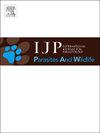Patterns of intestinal parasite prevalence in brown bears (Ursus arctos) revealed by a 3-year survey on the Shiretoko peninsula, Hokkaido, Japan
IF 2.2
3区 医学
Q3 ECOLOGY
International Journal for Parasitology-Parasites and Wildlife
Pub Date : 2025-02-19
DOI:10.1016/j.ijppaw.2025.101048
引用次数: 0
Abstract
This study examined the parasite fauna of wild brown bears and differences in the likelihood of parasite detection by season (summer vs autumn), year, and host factors (sex and age class). From June 2022 to November 2024, 334 fecal samples were collected from the Shiretoko Peninsula, Hokkaido, Japan, and examined for parasites using the centrifugal flotation technique. Fecal DNA analysis and data from a long-term field monitoring survey led to the identification of 49 individuals, which were further classified based on sex and age. Parasites detected in the feces included Uncinaria sp. (35.0% of total samples), Baylisascaris transfuga (13.5%), Dibothriocephalus nihonkaiensis (8.4%), Strongylida (2.7%), Capillariidae (0.6%), and coccidia (0.6%). The prevalence of detection for D. nihonkaiensis tended to be higher in autumn (September–November) than in summer (May–August). The likelihood of B. transfuga and Uncinaria sp. detection varied by season, year, and bear age class. The likelihood of B. transfuga detection was significantly higher in autumn than in summer, and tended to be higher in young bears (0–2 years) than in subadult/adult (≥3 years) bears, whereas that of Uncinaria sp. was significantly higher in summer than in autumn and in subadult/adult than in young bears. Egg shedding by these three parasites tended to disappear before or during hibernation. These results suggest that the likelihood of parasite detection in brown bear reflects the interactions of environmental and host factors, including seasonal and/or annual changes in diet, winter hibernation, and host growth.

在日本北海道知子半岛进行的一项为期3年的调查揭示了棕熊肠道寄生虫流行模式
本研究考察了野生棕熊的寄生虫动物群,以及季节(夏季与秋季)、年份和宿主因素(性别和年龄类别)在寄生虫检测可能性方面的差异。从2022年6月至2024年11月,在日本北海道知子半岛收集了334份粪便样本,并使用离心浮选技术检测寄生虫。粪便DNA分析和来自长期野外监测调查的数据确定了49个个体,并根据性别和年龄进一步分类。粪便中检出的寄生虫包括钩蚴(占总样本的35.0%)、变形贝氏蛔虫(13.5%)、日本海双虫头蚴(8.4%)、圆线虫(2.7%)、毛线虫科(0.6%)和球虫(0.6%)。秋季(9 - 11月)nihonkaid的检出率高于夏季(5 - 8月)。在不同的季节、年份和熊的年龄类别中,检测到transfuga和Uncinaria的可能性有所不同。秋冬季节检测到transfuga芽孢杆菌的可能性显著高于夏季,且在0 ~ 2岁的幼熊中检测到该芽孢杆菌的可能性高于亚成年/成年(≥3岁)熊,而在夏季检测到Uncinaria sp.的可能性显著高于秋季,在亚成年/成年熊中检测到Uncinaria sp.的可能性显著高于幼熊。这三种寄生虫的产卵在冬眠前或冬眠期间趋于消失。这些结果表明,在棕熊中检测到寄生虫的可能性反映了环境和宿主因素的相互作用,包括季节和/或年度饮食变化、冬季冬眠和宿主生长。
本文章由计算机程序翻译,如有差异,请以英文原文为准。
求助全文
约1分钟内获得全文
求助全文
来源期刊

International Journal for Parasitology-Parasites and Wildlife
Medicine-Infectious Diseases
CiteScore
3.80
自引率
5.60%
发文量
113
审稿时长
45 days
期刊介绍:
The International Journal for Parasitology: Parasites and Wildlife (IJP-PAW) publishes the results of original research on parasites of all wildlife, invertebrate and vertebrate. This includes free-ranging, wild populations, as well as captive wildlife, semi-domesticated species (e.g. reindeer) and farmed populations of recently domesticated or wild-captured species (e.g. cultured fishes). Articles on all aspects of wildlife parasitology are welcomed including taxonomy, biodiversity and distribution, ecology and epidemiology, population biology and host-parasite relationships. The impact of parasites on the health and conservation of wildlife is seen as an important area covered by the journal especially the potential role of environmental factors, for example climate. Also important to the journal is ''one health'' and the nature of interactions between wildlife, people and domestic animals, including disease emergence and zoonoses.
 求助内容:
求助内容: 应助结果提醒方式:
应助结果提醒方式:


